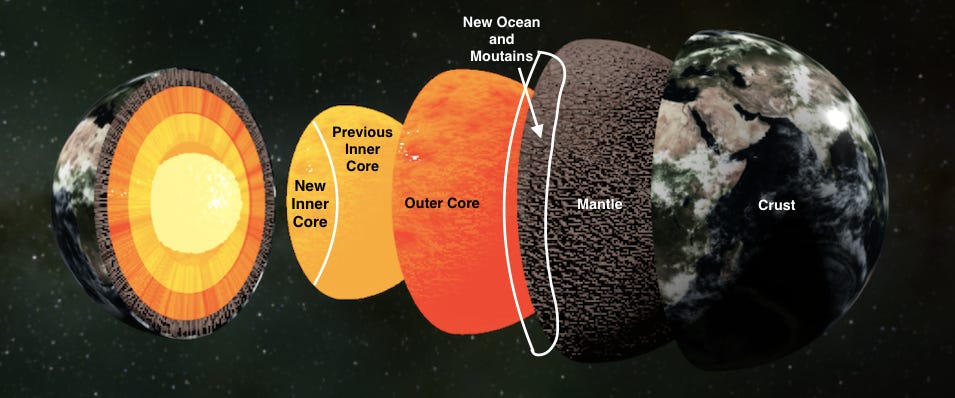Hiya!
I used to think that, for the most part, we knew it all. I figured academics and scientists already figured everything out about us, our planet, and the Universe. It wasn’t until much later that I realized we really don’t know that much at all. We’re just doing the best we can with the information we have. Still, it never ceases to amaze me when something I once considered a settled matter turns out to be anything but.
For instance, I learned about the various layers of the Earth years ago in grade school, then again in high school. They were taught matter-of-factly, and I deemed the information irrelevant and haven’t thought about it since. That is, until last week when I discovered that not even the Earth’s layers are a settled matter because scientists recently discovered not one but two new layers beneath our feet.
Previously Known Layers of the Earth
Unless you remember geology class well, it might be helpful to review the previously known layers of the Earth before we get to the fun stuff. But don’t worry. I’ll be quick. Behold the image below for a visual non-scale representation of the Earth’s layers:

Our home sweet home was believed to have four layers—an inner core, an outer core, a mantle, and a crust.
Starting from the inside and working out, according to NASA, Earth’s inner core is solid and about 759 miles (1,221 kilometers) in radius, while the outer core, surrounding the inner core, is more liquid and about 1,400 miles (2,300 kilometers) thick.
Together, the Earth’s complete core can reach temperatures as high as 9,800 degrees Fahrenheit (5,400 degrees Celsius) and is believed to be made of nickel and iron. The inner core is incredibly dense, and its intense heat creates a convection current in the liquid outer core. This is what produces Earth’s magnetic field, which protects life on the planet from harmful cosmic radiation.
Next up is the mantle, which is the middle and thickest layer. It lays between the crust and core and is around 1,800 miles (2,900 kilometers) thick. Meanwhile, Earth’s most surface layer is the crust, which is an average of 19-ish miles (30 kilometers) thick. However, it ranges between about 3 to more than 40 miles (between 5 and 70 km) thick depending on location.
The crust is the thinnest in the ocean. Even though the crust may feel massive, considering it spans several miles deep and blankets the entire planet, in truth, the crust is only about 1 percent of the planet. Meanwhile, the mantle makes up a remarkable 84 percent.
Oceans and Mountains Below Our Feet
Ok, now for the fun stuff. If the study published on April 5, 2023, in Science Advances by a team of researchers from the University of Alabama, Arizona State University, and the University of Leeds is correct, then between Earth’s mantle and outer core is an ancient ocean floor and lots and lots of mountains—some of which dwarf even the tallest ones we have on the surface.
For the study, the crew of researchers made four trips to Antarctica over three years to collect seismic data from 15 network stations buried throughout the continent. These aren’t any ordinary stations, though. They provided the researchers with the first-ever high-resolution view of the Earth’s mantle in the southern hemisphere.
So, you know, kind of a big deal because this precious data allowed the team to create a new, more complete, high-resolution image mapping the Earth’s interior using seismic waves.
As exciting as that is, when the team reviewed the three years’ worth of data, they discovered “unexpected energy” about 2,000 feet (914 meters) between the mantle and the outer core. The researchers realized that what was previously assumed to be smatterings was a “dense, yet thick, sunk ocean floor.”
See, previous studies noticed these patches, but without the additional seismic data from Antarctica, experts thought the anomaly to be random areas of denser materials than the surrounding mantle makeup. These areas become known as ultra-low velocity zones.
But now, with the additional information from Antarctica, the researchers suggest that rather than separate, patchy areas, it’s actually a layer spanning between 3 to over 25 miles (4.8 to over 40 km) thick surrounding the entire core-mantle boundary.
It’s much thinner than Earth’s other layers, but Edward Garnero of Arizona State University is quick to remind us that there are also “mountains on the core, in some places up to five times taller than Mount Everest.” And in a news release, a geological sciences professor at Alabama and the study’s lead author, Samantha Hansen, said:
“Seismic investigations, such as ours, provide the highest resolution imaging of the interior structure of our planet, and we are finding that this structure is vastly more complicated than once thought. Our research provides important connections between shallow and deep Earth structure and the overall processes driving our planet.”
They believe this layer is an ancient ocean floor that slid farther underground as the planet’s tectonic plates shifted. In the same news release, the researchers explain how it would happen.
“Oceanic material is carried into the interior of the planet where two tectonic plates meet and one dives beneath the other, known as subduction zones. Accumulations of subducted oceanic material collect along the core-mantle boundary and are pushed by the slowly flowing rock in the mantle over geologic time.”
As for what, if any, role this newly discovered layer plays in the Earth’s system, the researchers speculate it could be a key component in determining the rate of heat escaping from the core.
Yet, if you can believe it, this isn’t the only additional layer scientists have discovered inside the Earth. It turns out there’s another core inside the core.
A Core Inside the Core
Studying deep inside the Earth is anything but easy. As we discussed, the inner core is considered 762 miles in diameter, which sounds big, but it only makes up less than 1 percent of the planet’s volume — making it one of the most challenging areas to study.
But a duo of experts appears to have managed to. The pair of researchers from the Australian National University in Canberra published a study in Nature Communications on February 21, 2023, less than a month before the last one we discussed. In it, they show evidence of an “innermost inner core” within the Earth, a ball roughly 400 miles (644 km) thick and composed primarily of iron.
See, before, scientists created models of Earth’s inner core by analyzing the travel times of seismological events as they traveled along the Earth’s diameter. In other words, they studied the speed of seismic waves created by an earthquake as they traveled through the core because the waves travel at different speeds through Earth’s various layers depending on their composition, temperature, and density.
But in the new study, researchers watched how seismic waves bounced from one side of the planet’s interior to the other, like a ping pong ball. The additional sensors around Antarctica and even more scattered around the Earth over the last three years allowed the experts to track even the weaker rebounding waves traveling through Earth. In some cases, the waves travel through the planet’s core up to five times.
When they finished, they were astonished to discover the results showed different speeds and angles of seismic activity between what was thought to be the inner core and what appears to be the actual inner core.
After further analysis, the researchers believe the new core is made of an iron-nickel alloy, similar to other parts of the core. One difference between the cores is the new inner core is believed to have a different crystal structure which can cause seismic waves to travel at different speeds than its outer-inner core.
So now, based on the team’s discovery, what used to be considered the Earth's inner core, is actually the real inner core’s outer shell. Aside from surprise, though, researchers want to know what role this newly found inner core plays within the Earth’s systems.
As of now, scientists have a sneaking suspicion that, like its surrounding core, it probably has something to do with Earth’s magnetic field. In their study, they explain:
“Although the geomagnetic field might have preceded the inner core's birth, detectable changes in the inner core’s structures with depth could signify shifts in the geomagnetic field's operation, which could have profoundly influenced the Earth's evolution and its eco-system.”
If further research proves the innermost part of the inner core is what they think it is, the researchers believe it could help teach us more about the Earth’s evolution in the distant past.
Perspective Shift
Considering the recent studies, it seems that diagram from before should look a little more like this:

Please forgive my poor drawing skills, but you get the point. So now, instead of four layers, it appears the Earth actually has at least six—half of which make up the core. While interesting, this knowledge may seem somewhat irrelevant at first glance. But their existence is a big deal for geologists.
For instance, the researchers who discovered the underground mountains explained in the press release that the mountains could help them better understand how heat escapes from the core(s). Also, the ancient ocean floor can become entrained within the mantle hot spots or plumes that travel back to the surface via volcanic eruptions. Plus, learning about the core can help experts better understand the Earth’s magnetic field, which significantly impacts and protects all life on the surface.
For us, though, it’s a good reminder to remain humble in our declarations. After all, these days, even long-held assumptions are being proven wrong.
Want more? I also write on Medium! If you’re not already a member, you can sign up here to read mine and thousands of other independent writers to your heart’s content. Plus, a portion of your subscription will go to helping me pay my bills.
Do you have a curiosity but don’t have the time or energy to investigate it on your own? Let me do it for you! Just head to my Ko-fi page to commission me. You can also show me some love with a small donation on Ko-fi or by simply sharing the newsletter on your social media.
Thank you for reading. I appreciate you!




